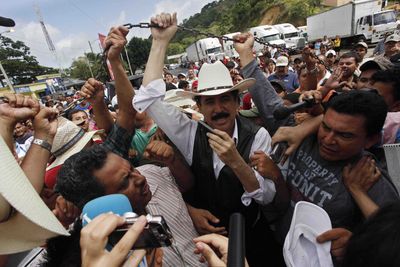Zelaya re-enters Honduras briefly

LAS MANOS, Nicaragua – Ousted President Manuel Zelaya’s plans for a triumphant return to Honduras on Friday fizzled into a brief, 15-foot stroll across this border post – yet another twist in his homeland’s month-long political crisis.
Morning began with high hopes: “My presence in Honduras can undo this coup,” Zelaya declared. “The people will surround me, and the soldiers will lower their rifles.”
By afternoon, it was clear it wasn’t going to happen. Honduran police began a lunch-hour curfew along the border, so the crowds that Zelaya and his entourage were hoping would usher him safely to the Honduran capital of Tegucigalpa had not materialized.
Instead, in a chaotic scene, Zelaya briefly crossed over onto Honduran soil for the first time since his June 28 ouster – and had his picture taken beside a “Welcome to Honduras” sign.
It was unclear late Friday what the exiled Honduran president’s next move would be. State Department spokesman P.J. Crowley told reporters Zelaya was expected in Washington, D.C., on Tuesday.
Honduras was plunged into political crisis on June 28 when his army’s soldiers ousted him at gunpoint, in his pajamas, by order of the supreme court in a bloodless coup.
The United Nations, the Organization of American States and the U.S. government condemned the move, but Costa Rican President Oscar Arias, the Nobel laureate, has so far failed to mediate to let Zelaya complete his term as president, which expires in January.
In Washington, Secretary of State Hillary Rodham Clinton labeled Zelaya’s border crossing Friday as “reckless.” It would not help restore democratic and constitutional order in Honduras, she added.
The government of Roberto Micheletti has said the only way Zelaya would return would be to face charges of abuse of power, treason and usurping his duties. The attorney general’s office has also said it is pursuing charges of corruption and misuse of funds.
At the time of his ouster, opponents looked suspiciously at his attempts to hold a referendum that would have allowed him to redraft the constitution. It was seen as a power grab.
Zelaya was wearing his trademark cowboy hat for his first step onto Honduran soil, surrounded by dozens of supporters and a crush of journalists. He was also accompanied to the border by Venezuela’s foreign minister, Nicholas Maduro.
All that had separated him from Honduras was a knee-high chain stretched along the Nicaraguan border. So he stepped over the line about 4:30 p.m. EDT.
The moment appeared to have been preceded by some sort of negotiation. Zelaya had just spoken with the ranking Honduran army officer on the border, Lt. Col. Luis Decarte.
“For the impoverished of the world, democracy is a weapon, an instrument to fight for justice,” Zelaya declared.
He stayed only about 15 minutes on his native soil before leading the crowd back across the border into safe haven in Nicaragua.